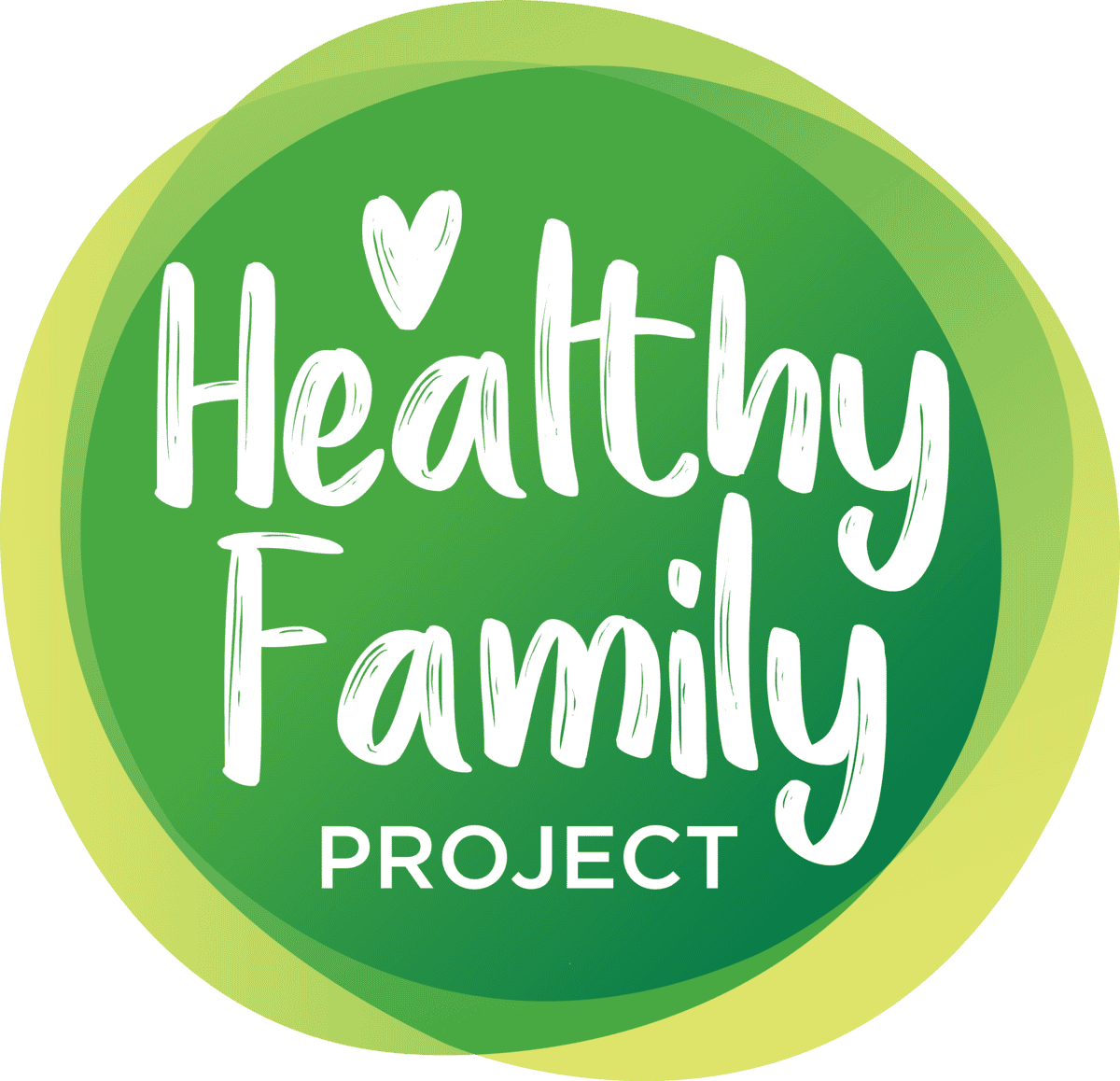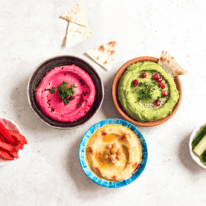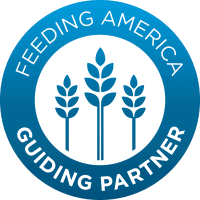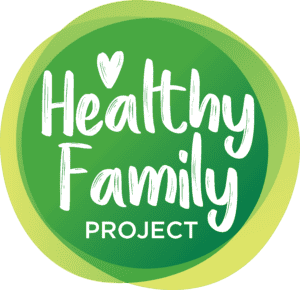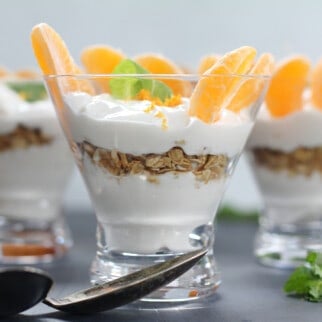Episode 54: Family Dinner Conversation Starters

In this episode of Healthy Family Project, we talk to Richard McCarthy, Meatless Monday Culinary Ambassador, about the importance of family dinner and how families can kick start important conversations at the dinner table.
Richard McCarthy is a community development specialist, whose quest for behavior change always puts carrots ahead of sticks. In 2005, he developed one of the nation’s first farmers market incentive programs to promote local vegetable consumption among SNAP consumers in New Orleans.
Based in Brooklyn, NY, he spends hours in the kitchen with his wife and daughter exploring the traditional knowledge of global cuisines that take ordinary and affordable ingredients to prepare culinary surprises that put vegetables first. An author, broadcaster, and organizer, he values food as the bridge between people.
- Writings: Slow Down with Banana com Queijo
- Radio: Farmers Market Minute on WWNO-FM
- Video: From Disaster to Dessert on rebuilding after Hurricane Katrina; Debate with Sam Kass at the James Beard Foundation
Healthy Bite Featuring US Cranberries
Today, we’re snacking on No-Bake Cranberry Pistachio Bites! Packed with oats, dried cranberries, pistachios, peanut butter, and flaxseed, with a touch of sweetness from the maple syrup, these granola bites will help fill kids up and keep hunger at bay until dinner. No baking required and easy enough that kids can prep themselves. We partnered with US Cranberries to share more delicious ways to use cranberries this summer.
Listener Survey!
Thank you so much for supporting the Healthy Family Project Podcast! We’d love it if you could take 5 minutes to let us know how we can bring you the best possible content for future episodes. Take the survey here.
Healthy Recipes & Tips in Your Inbox
Sign up for the Healthy Family Project e-newsletter to receive healthy recipe inspiration, our latest blog posts and more directly to your inbox each week.
Healthy Family Project Facebook Group
Join our Healthy Family Project Facebook group! This group will serve as a safe space for parents and caregivers to talk all about raising a healthy family – from dealing with a picky eater and tips to get more fruits and veggies onto plates to exercising as a family and mental health. We welcome all of you to join in!
Want to skip straight to a hot topic? See time stamps below. But of course, we recommend listening all the way through!
- 3:59 Welcome, Richard!
- 5:54 Why are family meals important?
- 12:13 Starting Family Conversations: Rose & Thorns
- 14:11 How to get family conversations flowing
- 19:53 How to engage with your tweens and teens
- 23:14 Healthy Bite Featuring US Cranberries
- 25:22 Why is it important for kids to have a say in dinner?
- 31:01 The benefits of exploring different cultures through food
- 35:56 What does a healthy family mean to you?
Relevant Links
- Check out our newly designed website!
- Shop our #WhatsYourCause shirts & give back to Feeding America
- Follow MeatlessMonday on Instagram & Facebook
- Get recipe ideas from Meatless Monday
- Jump Start Dinner with These Conversation Starters
- Kids Cook Monday
- Slow Food International
Other Podcast Episodes to Check Out:
- Episode 52: Fresh Produce 101: How to Pick, Clean & Store
- Episode 48: Conquering Mealtime Struggles
- Episode 35: Helpings Kids Make Good Choices
Healthy Family Project Podcast
Conversations covering hot topics in the world of health, food and family with a dose of fun. Helping families ease their way into a new fresh and healthy world.
Be on the lookout for new bi-weekly episodes and don’t forget to subscribe on Apple Podcasts, Google Podcasts, Spotify or your favorite podcasting site. If you like an episode, make sure to leave a rating and comment.
If you are interested in being a guest on the Healthy Family Project podcast, contact amanda@healthyfamilyproject.com with your topic idea for consideration.
Transcript for Episode 54
This transcript was produced by Otter.Ai. Please forgive any misspellings and grammatical errors.
00:09
Welcome to the healthy family project by produce for kids, covering the hot topics in the world of health,
food and family with a dose of fun. Hi, everyone. I’m your host, Amanda, and glad to be back with you all
today. Hopefully, if you’ve you’ve joined me over in the healthy family Project Facebook group, if not,
please join us we’re talking everything healthy family food, current events, you name it, I remind
everyone, it’s a safe space for voices to be heard and I hope allows all of us to help each other. That’s
the point we’re in there talking back and forth and helping each other down this path of, of parenting and
family helps us to be better and more thoughtful people. We also have new summer recipes over on
produce for kids calm. And speaking of produce for kids.com. Our website how to make over. We are
excited to hear what you think I am loving the new design and set up. So get over there and let us know
what you think about the new site. And then big news I talked about a little bit about this last week. In an
effort to support feeding America’s efforts to those in need during the corona virus time, we are selling
our fruits and veggies and giving back T shirts. With 100% of the proceeds going to the Feeding America
COVID-19 Response Fund, you have to see the shirts, I can say fruits and veggies and giving back all
day long, but you have to take a look at those. So we will link up in our show notes. You can also see the
shirts on our Instagram and Facebook pages. And there’s direct links as their direct links there as well. I
am truly I’m always stopped and asked about my shirt and I’m so glad we can sell them to make a
difference. Today we are talking to Richard McCarthy, Meatless Monday ambassador to slow food
International, all about dinner time, meal time, conversation starters, and how to see food and eating as
an adventure. So I think at this moment in our world where we’re kind of all been forced to slow down just
just a bit and have more family meals together. It’s a great time to talk about this. Also, with so much
going on in the world. You know, it’s a good time to have conversations at the dinner table around current
events, and helping our kids to understand what’s going on in the world and how they can help and make
a difference. You know it produce for kids. We’re all about bettering our communities. And we were
happy to learn something that that Richard developed one of the nation’s first farmers market incentive
programs to promote local vegetable consumption among snap consumers in New Orleans. So yay, we
love that. Now Richard is based in Brooklyn, New York, and he spends hours in the kitchen with his wife
and daughter. Exploring the traditional knowledge of global cuisines that take ordinary and affordable
ingredients to prepare culinary surprises that put you guessed it, vegetables first. So he’s an author,
broadcaster and an organizer. Richard truly values food as the bridge between people which will we’ll
learn more about that here in a few minutes. And that is why he is here today to talk to us all about these
dinner conversation starters and beyond. And of course, we have a few laughs But I guess I don’t need
to tell you guys that by now. So let’s get started. Welcome to the show. Richard. Before we start our chat
today, can you tell our listeners a little about you and the amazing work you do for the Meatless Monday
efforts and slow food USA?
04:00
Sure. Thank you so much for having me. I am a lifelong community development activist through foods
so from farmers markets to the dinner table. I’m always looking for ways to build community through
food. And we do that through utilizing Mondays as a day to think about what we eat together and slow
food to embrace the pleasure and responsibilities of the table.
04:30
Wonderful. Well, I had a little bit of time yesterday, I will actually, you know, produce for kids. We work
closely with Meatless Monday and support all of their efforts. And I took some time I hadn’t been on their
website in a while. But I took some time yesterday. They have some great videos available and different
blog posts. So we’ll link up to everything in the show notes so that listeners can head over there and grab
all of that good information. So Okay, so today we’re talking about a few different things. dinner
conversation starters being one of those. So I know we’re living in kind of a day to day, I guess mode this
year. But one positive, I’m not, I’m no longer allowed to say silver lining. My daughter, Charlie said I was
overusing that word. So now called the sunny side. So I guess one of the sunny sides of our day to day
living that we’re in right now is that we are spending more time together as a family. We’re having more
family meals. I kind of by force, but hey, it’s okay. And I know so I know you are passionate about the
value of eating meals together and that dinner conversation. I think most of us get that, you know, we
know Yeah, family meals are important. But can you tell us why?
05:54
Sure. And I think the why also, especially now, because the the boundaries in our lives have become so
blurred. Because we’re home, we’re here together all the time. And as a result, we’re really struggling to
figure out structure. And there is real value in having the structure of meals together, it marks the time of
the day, it marks the strange and rare social space where we put our phones away, we sit together and
we enjoy a meal together. And while at slow food and Meatless Monday, We’re particularly concerned
about the food we eat, and the foods we don’t eat. If we step back, you know, maybe one step back
away from the table. We’re also concerned about just the social nature of eating together, there is real
value in carving out that time together as a family, to to learn, again, the art of conversation, as compared
to, especially in this era, so many people are growing comfortable with eating alone. And the problem
with eating alone, as you eat more, you eat more quickly. And instead, when you actually have a
conversation, you are reminded that food is not just this fuel that we put in our bodies, but it is a bridge to
other places to other people, and I think importantly, to each other.
07:30
I agree. And I definitely think that us my family, we’ve discovered, I’ve discovered things about my family
members that I may have skimmed over in the past, you know, and sad to say it took kind of this time of
force slow down to do that. But it’s been interesting, to say the least. I feel like I feel like I’ve definitely
learned a lot we I could go down that path of distance learning to I said, I feel like I finally understand
truly how both of my children learn. And it wasn’t in an just kind of going off track as the little bit. But you
know, I feel like it wasn’t the most stress free time to understand how my children learned Oh, again, I
was forced. But I think it is something that I’ll carry on now, you know, as they move through their
education or life and see some red flags and things like that. So definitely, I feel like a lot to learn. And
I’ve learned a lot over this time with those family meals, even if it’s a breakfast, you know, and I think
sometimes we tend to think of sitting around the dinner table. But you know, we’ve we’ve been having
breakfast together. We’ve been having lunch together. So I definitely think any meal and anytime you can
can have those conversations as good.
08:59
Well, you know, that that, that that whole question of time is one that has really been bent during this
strange period of this sort of great pause. Yes, people don’t have lunch to breakfast together, even
though the images of television commercials are people sitting together. breakfast cereal and eggs and
whatnot. And in actual fact, it’s it’s people running out of the door. It is and breakfast is an interesting
moment. And of course it varies on different places and cultures. And of course lunch being a meal that
we would never have together because we’re at school or we’re at work and I do think it is worth
treasuring these, this this rare moment where we can reconnect and, and so food is almost the tool that
brings us together. But then you know, the question is when you bring people together around the table,
many of the images that are shaped by, by, by film and television is that it is a rather austere and severe
place the dinner table, you know, you must be screened, don’t talk. That’s true. Learning table manners.
And you know, there are other places that look at it very differently. And it becomes a very warm place
where we reconnect. And we found, you know, during this period of rather strange crisis, our family with
my now grown, you know, university aged daughter stayed with us for two months. And we were
reminded of the last time we had this intense time together was in the crisis of after Hurricane Katrina,
where we had to be refugees for several months in Houston, from our hometown of New Orleans. And
what we found in that period afterwards was, she was a fan of a very young age of, you know, sit around
the dinner table, and she came back home from school with this idea of conversations at the dinner
table, and she attended a French school on the friendship very intense about preserving the dignity of
the table. And she came back with this idea of what we did this game at lunch, where we, we talk about
today’s roses and thorns. And, you know, she was the one introduce the idea, not the parents, but the
child. And we thought this is a marvelous idea to, to actually start the conversation around, you know, we
go around, and we take turns, so it becomes like a game, you know, the, you know, the question, do you
start with the rose? Or do you start with the thorn. And it was great, because we’d start with a thought,
and let’s start with what happened today. That wasn’t good. It was bad. It was thorny. And we’d go
around and take turns. And it was, it became actually not, not the usual I’m talking but the excitement to
listen to what someone else was going to come out with, and what surprises they would come out with.
And sometimes they would all be the same thing. We’re all angry about the same thing or happy about
the same thing. And then we you know, we finish up with the rose, what was the rose of today, and it was
a great moment to, I think navigate rather tricky issues. And I think in families, it’s very difficult to talk
about trauma and fear. We don’t want to, you know, we want to protect our children from, you know, the
fearful things that are happening outside. So it was a chance to bring some transparency into our house
around the dinner table to talk about difficult issues. And I think that is of course, the great value of the
dinner table. We’re not texting we’re talking.
13:08
Right? Right. It’s it’s definitely a good way to kind of bring up those hot or those hard topics like you said,
we do something similar peaks and Pitt’s I think it’s along with food so but it’s it’s funny without actually
that was my next question. So we’re perfectly on track. I said, I was gonna ask you, you know, where do
you start? Because I think sometimes, you know, families, like you said, there’s been trauma, there’s
been tragedy, maybe different families are going through different things. And conversation is just seems
like a heart. You know, like, it’s gonna take everything you have all your strength to kind of figure out a
way for us all to be nice and talk to each other. I know, it sounds crazy, but I know there’s many families
out there and some days even here in my own house, that the conversations don’t come as easily. So
where do we start? I think those the rose and Thorne is a good idea. I think the peaks and Pitt’s which is
similar. Well, we do but how do you get things going?
14:13
Oh, I do think food is a good place to get it going. You know, just talking about what are we having
tonight, you know, or today, getting them involved with preparing or, or setting the table. I mean, these
are, you know, rather old fashioned ideas, but ones that that that mean that all of us who come to the
table are protagonists. And and I think this is something that it’s slow food and Meatless Monday we’re
particularly interested in is leaning forward and taking some accountability, responsibility for our actions
together and how it affects each other. And so, you know, actually discussing what we’re eating tonight
and or you know, Eating today, and especially if different family members can play a role in preparing it
and bringing it together. This is something that, you know, we had developed with, you know, Alice
Waters, and her Edible Schoolyard is very, very clear about is that the table should be something that we
treasure, there should be flowers in the middle of the table, even in public schools, that everyone has a
job to fill the water glasses to bring things to the table, set the table. And so talking about food is not a
bad place to start. You know, we are particularly interested in in kids becoming protagonists in their lives.
So how do they do that? Well, they become knowledgeable about what we’re eating, what’s going on in
the world. And, and I think that, that, that that hope that they become protagonists and make decisions
and have opinions, and that the table is a safe place for people to voice their their views, does start to cut
into what is otherwise a rather authoritarian picture of parents raising children and parents requiring their
kids to behave at the table. Rather than that sort of authoritarian picture can become much more
participatory.
16:23
Right. And I like that. I feel like that’s kind of eye opening you when you said that earlier about the
depiction of the dinner table, you know, and how that US authoritarian and how you eat your eat your
greens, and why are you eating with your hands? That’s yeah, you know, that’s something that comes up
in my house, I’m like, you have a fork, you have a fork.
16:47
And it’s, you know, it’s interesting, you know, because, you know, one of the, you know, important
collaboration between slow foods that is interested in, you know, pleasure and responsibility of food and
food is an adventure and Meatless Monday, which is we must reduce the meat consumption. And
Monday is a great day to try that out. As we begin to explore the world of food, of course, are places
where people do eat with their hands, whether it’s Ethiopia or Bangladesh. And it’s important which hand
you use, and, you know, back be a fun experiment,
17:24
to say I think I’m going to do it. When you know
17:27
if it’s if you’re making a you know, a rather simple curried lentil and rice dish with using, you know, make
maybe even making on the, you know, the bread or Parata, which isn’t that complicated. And then use
that to eat with rather than forks and knives, then my gosh, the dinner table, it’s so crazy, you do
something like that out of the blue, once. It’s the kind of meal that they’ll remember for 20 years. And
they’ll say, you remember that time we didn’t eat with forks and knives. It’s crazy. And, you know, those
food memories are really important in shaping how as they grow to become adults, they look at food as
food, something they fear, and something that intimidates them because, oh my gosh, I remember there
all these rules, and I wasn’t sure what to do and was I allowed to put my elbows on the table. But if
instead food, and the dinner table becomes this adventure that we explore, tastes and sounds and
flavors and colors and smells, then their relationship to food changes. And you know, of course, we want
kids to run towards the good food because they’re excited about it, because they have a relationship to it.
You know, this is why gardens matter, because, you know, if you grow a carrot, well, you know, your
carrot is gonna taste better than any carrot you’ve ever eaten, because you had a role in it. Similarly, if
you’re knowledgeable about the place from where this particular ingredient or food comes from, then you
have a connection and you have authorship over you become a protagonist. And I think that is the you
know, the the sunny side. Yes.
19:13
Charlie will be help. Happy to hear. Okay, so and I think we I have some good ideas on this. So I had a
friend ask I swear it was a friend. This one isn’t from me. Do you have advice for kids? Who might be in
that? Yes or no answer phase, you know, the teens and tweens who really you know, they just want to
get to the table they want to eat and get on with it, you know, get back to their FaceTime or whatever
they might be doing. So how do you keep them captive just even for an extra few minutes? It’s such a an
age and an important age for conversation but yet it’s so hard.
19:53
It is so hard. You know it they become expert at rolling their eyes. I, you know, I think that it’s the small
things. I mean, it’s a little bit like when you know, the kids are small. Do you punish them? Or do you
distract them? And, you know, a way to distract maybe a teen or tween is maybe to give them the floor.
And Sarah, you can leave. But first, you need to ask me a question. And that then gives them the
opportunity to actually shape the discussion, because maybe they want to talk about something as you
know, insular and, and self absorbed as it may be, but they want to talk about what’s important to them.
And maybe by getting them to ask you something actually keeps them there. And, and it and it flips it.
That would maybe be one approach. It’s hard, though. It’s hard. You know, in particular, I mean, I think
we were lucky and that our daughter has had a she’s had a curious palate. So she would try new things.
Of course, once she liked something, she would only eat that thing for, you know, three weeks until she
was over it. But we, we tried something like she you know, she’s like, I don’t really like this. I never like
this, you know, I don’t like this way. Do I say that’s fine. You have to take a no thank you bite. This is
when she was young. And, and it was so funny how well that worked. We said, Look, you don’t eat the
whole thing. You don’t like it fine. But you’re gonna have to take one bite of that dish. And then you can
say no, thank you, I don’t really enjoy it. And it’s amazing how one bite becomes 10. And I think is this
game of outsmarting them as long as you can.
22:00
I mean, I do like that idea, though. Because I have recognized at that age, even this summer, as I’ve
been setting up, you know, virtual workshops and things for my older daughter. She just, she told me the
other day, she said, I’m it makes me so mad that you have you set these things up? And I have no say.
And I said, but but you don’t want to do these things. And she said, No, I want to do all of them. But I just
want to be involved in the process of looking and talking it through and making kind of making that
decision and not just having you telling me here’s my schedule for the week, you know, and so that really
made me think, you know, that the things are shifting and how important it is for them at that age, like
you said, to kind of take the floor a little bit and to ask the questions and kind of want to say they always
have to own the conversation. But for them I think owning that is they’re growing into that more
responsibility, you know, in their life and maturing that. That that’s really good advice. Oh, I have so many
things to take away today. All right, it’s time for another healthy bite Today brought to you by our friends
at US cranberries. And Grace is about to be here with a batch of dried cranberry energy bites, which I’m
really excited about. Hi, Grace.
23:28
Hey, man, I’m excited to bring you this healthy bite today.
23:31
Okay, talk to me about what you have here. It looks amazing.
23:34
Okay, so I have a whole batch of cranberry pistachio energy bites. These are so easy to make dried
cranberries, oats, peanut butter, pistachios, maple syrup, vanilla extract, and ground flaxseed. Mix it all
together refrigerate for an hour and shape into one inch rounds.
23:49
That sounds like the perfect recipe for the kids to help out with. I’m always looking for the extra set of
hands in a great snack to to have on hand to grab quickly instead of reaching for something not so
healthy. So okay, enough time here. Let me try this.
24:04
Enjoy. So what’s so great about the dried cranberries is that one they taste great, but also their sodium
fat and cholesterol free. What do you think Amanda?
24:12
This is really good. I’m gonna enjoy this for a minute.
24:16
You enjoy them. So there are also other varieties of these energy bites too. If you wanted to get creative
and use other seeds, you can use coconut and you can always swap out the peanut butter for a non nut
butter if needed.
24:28
Wow, these are really tasty. I know the girls would love to try these and make them
24:32
definitely I can picture your girls having a great time making these. Well.
24:36
Thank you grace. This has been delicious and fun and everyone be sure to check out the full recipe in
the show notes and find out more about cranberries at us. cranberries.com. Well, we talked a little bit
yesterday about my kids setting up a restaurant for my husband and I which I think I told you I thought oh
my gosh, this is going to be a mess. How am I going to just let them Am I really going Let them just do
the whole thing from top to bottom and stay out of it. And so it really worked out well. And I was, I mean, I
have beautiful pictures. It was a wonderful evening. And, you know, just I’m glad that I took the chance.
But why do you think it’s important for kids to have a handle on what is being made? And I think you kind
of talked a little bit about this earlier, but it seems that that does help in the dinner conversations.
25:30
Well, I think there’s so much pride in hospitality. And I think of all the years I’ve worked with chefs, one
thing that I have found to be a almost universal is, it makes them so happy to make other people happy.
There is some magic that, that that, that that, that occurs in their sense of well being and, and just just
general happiness, when they’re able to welcome and serve people in a setting that, that that is
enjoyable. And I think that’s a human trait. And, you know, hospitality and being the host, is again, I think
a little bit of an issue of control and authority. And parents are always, you know, putting it together, we
put heels together without even thinking about all of the logistics. And I think the more that they’re able to
learn the complexities of how timing and measurement and all the things that of course, I would have
been much better at math and science that they taught us through cooking, that it’s really complicated to
put together for a meal. And, and because it’s an accomplishment, it’s something that that elicits, you
know, pride of ownership and authorship and that they’re preparing something for you, they’re giving
back something that usually they are on the receiving end of. And I think that it can be a one off, it can be
a special event, I think there’s something rather nice about, you know, the table being the place where
special things happen. But it can also become the kind of habitual ritual that oh, you know, it’s, it’s
Wednesdays and Wednesdays are when you make us a meal. And maybe it’s just the first Wednesday
of the month, it doesn’t have to be so ambitious. But I think that they begin to appreciate how
complicated it is whether when you go out to eat, you know, you remember that phenomena of going out
to eat right. And, and what work it is to, to deliver a meal that’s hot, and well portioned and well seasoned
and all of that, that there’s some real skill. And I think that that is where they begin to appreciate the
dignity of labor, and the creativity involved. And and I think you certainly learn how they, how you cook is
often how you learn. I mean, I’m all improvisation, my wife is all following recipes. And that tells you so
much about personalities and what they’re well suited for, and what makes them comfortable and what
takes them outside their comfort zone. I think those are wonderful things. And I think so much in our food
system and in our lives, we sort of outsource it to the experts. And I think that’s part of what we need to
deconstruct. So, you know, you know, we talked a little bit about what they do in Helsinki with restaurant
day where all of the food regulations for the city are exempted on one day, and anyone can start a
restaurant for that one day. And it’s exciting because it dismantles the kind of humdrum of everyday life
and makes it special. And it brings surprise on board and, and I think learning the art of presentation
putting on a performance, it’s and it creates, I think, a sense of a fun that makes that that sort of
revolution of everyday life rather than just, oh, it’s time to start dinner and how much we dread the ordeal.
And instead, it makes it you know, a highlight of every day.
29:36
I like that and I think we are going to have once a month, Friday, one Friday a month. We’ll have to pick
what what it is but it was just so wonderful. And they enjoyed it and we enjoyed it. So I think we’re gonna
we’re gonna keep it up and it allows them to try new things to they they both like to look at recipes. And I
do have one who’s a improvisational kind of like how I I always get people saying, well, where? Where
can I find that recipe in his say, well, in my head like, well, I don’t know, I tasted it, then I cut this up and
added this. And then I did this. But then I wanted to add this, and I forgot I didn’t write it down, and
they’re like, oh, my gosh, you have so many great recipes, please start writing these things down. So I
know you’re also passionate about worldly foods and looking at food as an adventure. So yesterday, I
wrote down this quote from you, as we were talking, so I thought it was I feel like I need to put it
somewhere in my kitchen, exploring foods from different regions around the country, and even around
the world allows you to embrace diversity in a different way, and often demystifies other cultures. And
when I hurried up and scribble that down and thought, yes, that is exactly it. So how can the food we are
eating be part of the conversation? i You’ve said, bridging, you know, bridges you to different things. So
talk a little bit about that.
31:02
Well, you know, when you think about how we live in modern day life, we do tend to put up a lot of walls
around ourselves. And, you know, it’s I live in this neighborhood, I go to this school, I, I belong to this
party, you know, we tend to sort of create a lot of walls. And I think we find safety in that. And it’s a bit
terrifying to break beyond our, our safe zone. And as our communities become more diverse, and, you
know, strange foods come in, and strange people come in, and the life that we were used to becomes
much more surprising. Food does tend to be one of those great entry points, where we learn a how
diverse we are, and also how similar we are. And I, I think that how we how agile we become, and how
we learned how to navigate the unfamiliar, is increasingly going to become like that skill set that will help
people ease through this transition. And I think in particular, the pandemic transition is, guess what today
is full of uncertainty. And if uncertainty makes us want to crawl back in and hide behind walls, then it’s
going to be tough, it’s going to be tough going. If, on the other hand, we embrace the uncertainty and
begin to look around to find out who near us has something that brings great color and zest and life to
our lives, then we’re going to be much better off. And, you know, when we began to partner at slow food
began to partner with Meatless Monday. One of the things that we noticed with many of the recipes is
that many of the meatless recipes involve some kind of substitute, you know, for what we’re used to as
protein whether it’s tofu, tempeh, a or mock veggie, chicken nugget type things, and you know, all that’s
fine, but it is processed food. And instead, we began to explore the sort of the great peasant foods of the
world, which tends to be rice and beans, or, in some places, it’s beans and rice. It’s there variations on a
theme, whether it’s chickpeas or or or millet, or rice or red beans, or all this sort of amazing variety of
foods that can be prepared in such different ways. Oftentimes, it’s quite similar ingredients presented and
imagined very differently. You know, it’s chickpeas can be in a chickpea salad, and they can also be
crushed and blended with tahini and olive oil and become, you know, homeless and and I think it’s it it
inserts some creativity into how we navigate everyday life. And therefore, you know, food is something I
fell into professionally in developing Farmers Markets and Community Development through food. And
what I’ve found is 25 years later, I’m still there because I’m still learning and it still continues to be
fascinating to me how different cultures have value. Different ingredients so differently.
34:56
Right? i Yeah, that’s definitely in our house. I think Just in the past two years, we’ve really kind of stepped
out of our comfort zone and my husband is Cuban. And so he grew up in a all Cuban food district, you
know, really didn’t step out of that, that food realm at all. And when we met, you know, I was throwing
everything at him and he said, slow down. What are you doing? I hate the smell of that. Don’t cook that
kind of food. Don’t please just make this and finally now. Now he’s like, good, what happened to me? Oh,
now I’m a vegan. And I like, I don’t even know. It was like, swooped me in. And like now I this person. I’m
like, yes, it’s wonderful. Um, so Okay, so I asked all of our new guests on the podcast, the same
question. There’s no right or wrong answer. What do you think it means to be a healthy family? Gosh, I
know. No, right or wrong?
36:01
Well, I think a healthy family is one that has maybe two ingredients that are always present.
Transparency, I think it’s important to share how decisions are made internally. And also to not shield
them from everything that’s happening in the outside world. So I think that transparency is really
important. And and I think trust, you know, Trust is everything. And you can ask people to do kids to eat
the strangest foods if they trust you. And, and you have to preserve both that transparency and trust, I
think together.
36:47
I love it. Perfect. Okay, so, this has been wonderful. And we will be sure to link up to Meatless Monday
and Slow Food Nation in our show notes, and also any other links that you have for me to share with
listeners. But before we close things out, can you tell listeners where they can find and connect with
you?
37:08
Certainly. Oh, that’s great. Well, thank you for inviting me on here. Oh, my gosh. So quickly. The
meatless monday.gosh.org.com, the Meatless Monday website and Meatless Monday on Instagram. And
I mean, that’s great social presence is a marvelous place for recipes. And similarly, slow food.com, the
Slow Food International, which, you know, because we are all over the world is also a great place for
knowledge about to learn knowledge about ingredients and recipes. And I write Meatless Monday
column regularly for slow food International. And I do it as an international councillor for slow food. And
as the captain of think, like pirates,
38:06
wonderful, well, we will definitely link up to everything so people can easily click through and we’ll link up
to some of those recent columns as well over in the show notes. Thank you so much, Richard. So great
talking to you. I feel like I am gonna walk away and, and have some new things to implement with our
family. And it’s just been a real pleasure.
38:29
Oh, thank you. I really enjoyed it and you keep up your really important work. Thank you, Amanda.
38:34
Thank you, everyone, for continuing to join us in our healthy family project mission to create a healthier
generation. If you like the healthy family project, which I really hope you do. Please tell a friend and leave
us a rating it will only help our visibility so we can continue to share information with all of you. Be sure to
join the healthy family Project Facebook group. We love to keep this conversation going and if you have
topic ideas, things you want us to cover or someone you feel like we should talk to please let us know we
are definitely all about keeping this conversation going and continuing to bring you guests and topics that
are going to make a difference in your world. If you want to tweet direct with me I met Amanda and Kiefer
on Twitter and also on Instagram, and you can find produce for kids on Facebook, Twitter, Instagram,
Pinterest and YouTube. Be sure to subscribe Talk soon
